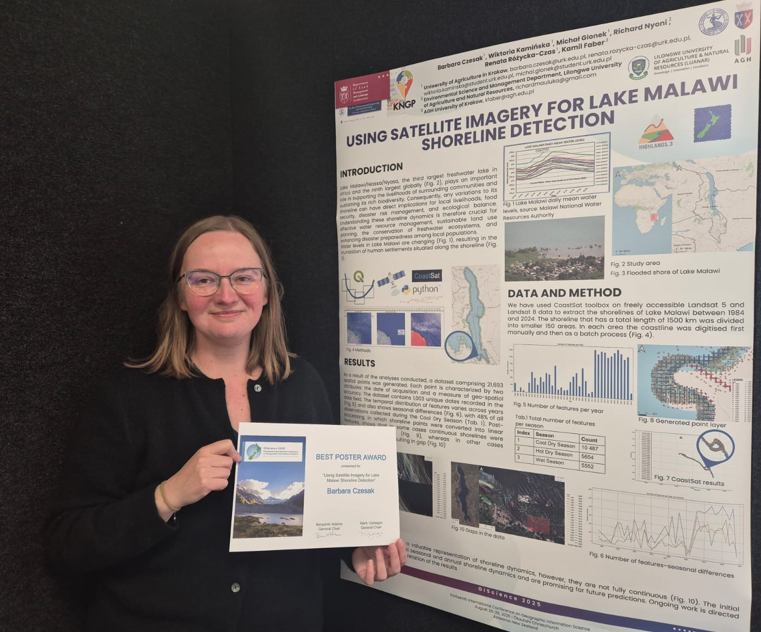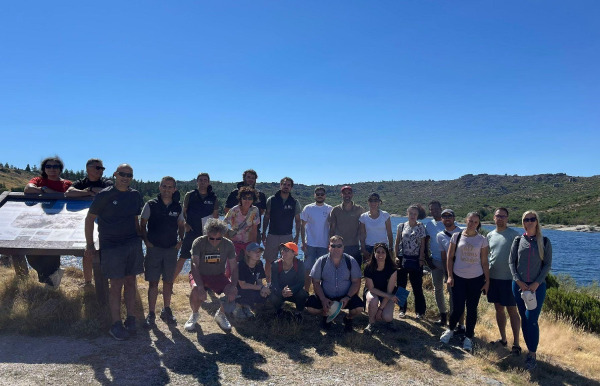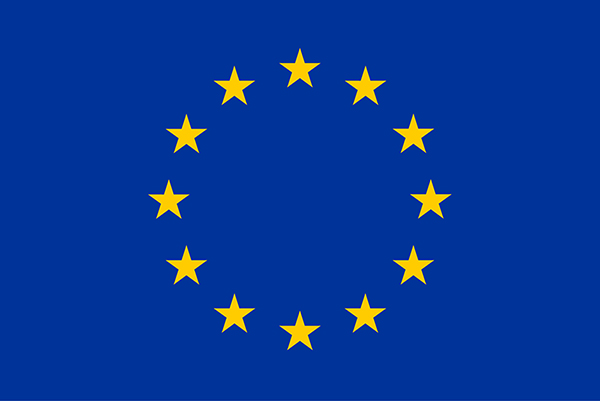- Details
Poster "Using Satellite Imagery for Lake Malawi Shoreline Detection” authored by Barbara Czesak, Wiktoria Kamińska, Michał Glonek, Richard Nyoni, Kamil Faber, and Renata Różycka-Czas has been recognised with the best poster award and selected out of 75 posters presented at the conference: GIScience 2025, Thirteenth International Conference on Geographic Information Science, August 26-29, 2025 | Ōtautahi Christchurch, Aotearoa New Zealand.
The research cooperation and research idea originate in the R&IS in Malawi. The poster was presented by Barbara Czesak on behalf of the co-authors. The award reflects the team’s dedication, innovative collaboration, and ability to communicate their findings with clarity and impact.
Abstract: Lake Malawi/Niassa/Nyasa, the third largest freshwater lake in Africa and the ninth largest globally, plays an important role in supporting the livelihoods of surrounding communities and sustaining its rich biodiversity. Consequently, any variations to its shoreline can have direct implications for local livelihoods, food security, disaster risk management, and ecological balance. Understanding these shoreline dynamics is therefore crucial for effective water resource management, sustainable land use planning, the conservation of freshwater ecosystems, and enhancing disaster preparedness among local populations. However, in developing countries access to geographic information is not the primary focus. In the reality of scarcity, it is extremely challenging to provide long term geographic information that could be sourced from in situ laborious measurements. This study addresses those challenges by using free satellite data for shoreline detection. We have tested CoastSat toolbox on Landsat 5 and Landsat 8 data to extract the shorelines of Lake Malawi between 1984 and 2024. The shoreline was divided into smaller 150 areas and in each area the coastline was digitised to improve the final results. However, we are aware of the limitation that CoastSat is optimized for sandy beaches, therefore, while the extracted shorelines provide a valuable representation of shoreline dynamics, they are not fully continuous. Ongoing work aims to refine the results. The initial findings give insights into past seasonal and annual shoreline dynamics and are promising for future predictions.
Conference website: https://giscience2025.org/

- Details
Julián Grijalba from UNIMAYOR (Colombia) is visiting th IGF in Innsbruck as part of his Secondment at the Biosphere Reserve "Großes Walsertal" in Austria. He researches about how people emotionally respond to the bioacoustic landscape of the Großes Walsertal Biosphere Reserve, using field recordings and lab-based listening experiments. It is part of a broader exchange between the “Urbanphony” and “Highlands.3” research initiatives.
You can read the full article here (only in spanish).
- Details
Vargas MEA, Pozo CA, Härter CJ., Kozloski G.V. et al (2025). Digestive and metabolic impact of using extruded-expelled soybean meal as a protein source for sheep fed with a total mixed ration. Archives of Animal Nutrition. https://www.tandfonline.com/doi/full/10.1080/1745039X.2025.2526364#abstract
ABSTRACT
This study aimed to evaluate the effect of including extruded-expelled soybean meal (ESBM) as the main protein source in a total mixed ration (TMR) offered to sheep on digestive and metabolic parameters, in comparison to protein sources with known nutritional properties: solvent-extracted soybean meal (SBM; high ruminal degradability) and dried distillers grains with solubles (DDGS; low ruminal degradability). Five Corriedale × Suffolk crossbreed male sheep (33.7 ± 4 kg body weight) fitted with ruminal catheters and duodenal cannulas were used in an incomplete double 3 × 3 Latin square design, comprising three experimental periods of 20 d each. On a dry matter basis, the TMR was composed of corn silage (0.60) and a mixture of concentrate feedstuffs (0.40), which included ground corn and one of three protein sources: ESBM, SBM, or DDGS. The sheep receiving TMR with ESBM showed intermediate organic matter digestibility compared to SBM and DDGS and lower neutral detergent fibre digestibility together with DDGS (p <0.05). Rumen fermentation and digestion variables were similar between ESBM and SBM, but the N use efficiency tended to be higher in ESBM (p <0.08). Compared to ESBM and SBM, DDGS decreased the N digestibility, the concentrations of ruminal ammonia-N and the urinary N losses, and increased the duodenal flow of non-ammonia non-microbial N (NANMN) and α-amino N (p <0.05). In conclusion, replacing SBM with ESBM in TMR offered to sheep did not impact most of the rumen fermentation and digestion variables whereas improved the efficiency of N utilisation. In contrast, replacing SBM with DDGS in TMR for sheep has been shown to reduce N losses through urine, increase the duodenal flow of dietary N, and improve N utilisation efficiency.
- Details
Wlodarski L, Delagarde R., Pozo CA,..., Kozloski GV (2024). Calculating herbage utilization and intake by dairy cows under subtropical conditions using conventional field measurement techniques or the HerbValo method. Tropical Animal Health and Production. https://doi.org/10.1007/s11250-023-03863-2
Abstract
Geographical Indications (GI) for agri-food products, as first developed in Europe, are gaining momentum globally, based on their assumed potential as rural development tools. However, to date, academic research has paid limited attention to their ability to meet the actual objectives of the stakeholders using them in other contexts, such as Latin America. To this end, the present paper analyses five case studies of GI designations, three in Peru and two in Ecuador. A qualitative method centred on the gathering of semi-structured interview data from different actors involved in the development and management of these GIs has been adopted. The analysis of these cases shows that these designations are valued, primarily, as tools for accessing international markets. Yet, the results also point to other objectives, most notably the contribution they can make to product differentiation and the empowerment of producers along the food chain. However, this article identifies a series of obstacles that hinder the meeting of these expectations, including a lack of alignment with the supply chain and market demands, and the multiple scales at which a GI has to be governed. Moreover, it is evident that the GIs are often granted without any consideration of the objectives and expectations of local actors. This appears to explain why, in some of the cases analysed, the GIs continue to exist solely on paper.
- Details
Aline Rodrigues Silva, Vicente Celestino Pires Silveira, Claudio Antonio Pozo et al. (2025). In situ digestibility method as an input-source in the context of the Pampa Corte model: predicting average daily gain by free-ranging cattle. Ciência Rural 55. Federal Universidade of Santa Maria. Center of Ciencias Rurais, Brazil. https://www.scielo.br/j/cr/a/S7pT5TCFhwFpVTRT6Nk79jf/?lang=en
ABSTRACT:
This study evaluated the adequacy of using digestibility values obtained by the in situ (ISOMD) method for predicting the average daily gain (ADG, g day-1) of free-ranging cattle through the Pampa Corte model. The evaluation was based on a data set compiled from two independent trials conducted with growing beef cattle grazing native grasslands of southern Brazil. Values of digestibility obtained through the N fecal method (FNOMD) were used as comparative reference in the present study. The predictions of ADG were performed at both individual (n= 41) and group (i.e. diet treatment within trials, n= 10) levels. Parameters generated from regression analyses between observed versus estimated values of ADG (i.e. determination coefficient (R2), root mean square error (RMSE), root mean square error of prediction (RMSEP), concordance correlation coefficient (CCC) and mean bias) were used to evaluate the predictive adequacy. The observed values of ADG were linearly related to those predicted by the Pampa Corte at both individual (R2= 0.52; RMSE= 148.9, CCC = 0.72, P < 0.05) and group levels (R2= 0.67; RMSE= 108.8, CCC = 0.81, P < 0.05), without effect of the method used to estimate herbage digestibility. However, compared to the FNOMD, the ISOMD resulted in higher mean bias of predictions (i.e. - 4.3 vs 61.6 g day-1). The ADG of free-ranging cattle grazing native grasslands of Southern Brazil can be adequately predicted by the Pampa Corte model using herbage digestibility values obtained through the ISOMD method. However, constraints associated with herbage sampling in heterogenous swards should be considered.
- Details
The Galician Web-Portal Xeografia.gal reported in a short article about the last steps of our project and the Final Meeting, which was held on the 12th and 13th of July. You can read the full article here (available only in Spanish).
- Details
Since mid-June, we’ve been on the road for the final Research & Innovation Session of our five-year EU project HIGHLANDS.3, dedicated to exploring and supporting sustainable development in mountain areas across the globe.
This final Session began in Galicia, Spain, with fieldwork in and around Monte Pindo, Trevinca, and Santiago de Compostela. Together with local communities, researchers, and policy actors, we examined territorial dynamics and collaborative knowledge production in mountain regions. Since early July, the work has continued in Tomar and Serra da Estrela, Portugal, where the last research activities and exchanges are taking place.
This weekend, our Final Meeting will mark the end of a unique journey that connected diverse mountain territories through participatory research, mutual learning, and innovation. From the Alps to the Andes, mountain regions in Malawi and Vietnam, from the Carpathians to the Pyrenees, HIGHLANDS.3 has demonstrated how mountain regions and local Initiatives can serve as key spaces for rethinking sustainability, governance, and resilience in times of social-ecological transformation.
Stay tuned for more insights and outcomes from this final phase.

- Details
Since the start of the last Research and Innovation Session in Spain and Portugal, there have been numerous reports in the local media. The general tone and consensus of our Highlands.3 project is very positive. Scientists from all over the world are welcomed with open arms and our goal of joint research and the common understanding and advancement of sustainable development in mountain areas is given great interest.
The following articles have been published so far (available only in spanish):
- University of Santiago de Compostela: Highlands.3 divulga o coñecemento xerado arredor das áreas de montaña e o seu desenvolvemento sustentable
- Diario Compostela: Trevinca, Monte Pindo y los Alpes se cruzan en Santiago para cerrar un proyecto europeo pionero
- La Region: A Veiga muestra al mundo los recursos de la montaña
- OSIL.info: Investigadores internacionais do proxecto europeo Highlands.3 visitan Trevinca (A Veiga)
- OSIL.info: A excelente conservación da paisaxe de montaña de Trevinca, na Veiga, sorprende aos expertos internacionais de Highlands.3
- SOMOS Comarca: Trevinca-A Veiga convértese en referente europeo do desenvolvemento sostible en montaña co proxecto Highlands.3
After two weeks in Spain, the group travelled to Portugal for the last ISDHs of Highlands.3 and the Closing Meeting, which will be held at the end of the Session (12th of July).
We will be happy to keep you informed about future articles and announcements.
- Details
Andrea Ceppatelli, Claudio A. Pozo, Celeste M. Bonnet , Alexandros Siampanopoulos, Mariana Vogg, Peg Strankman, Enrico Sturaro, Jean-François Tourrand and Liz Wedderburn.
Abstract This research investigates the benefits of the dairy value chain beyond food provision, and its contribution to inclusive sustainable development (ISDH) in European highlands. Transdisciplinary teams interviewed and analysed 11 cases related to the dairy value chain sourced from three highland regions in Europe: Alps (Austria, France, Italy), Massif Central (France), Pyrenees (Spain). Actors interviewed were farmers, cooperatives, retailers and associations. A systems thinking approach was applied to develop a conceptual map (Causal Loop Diagram, CLD) describing the contribution of the dairy value chain to ISDH, through the interpretation of the viewpoints of interviewed actors. For each case, the factors contributing to ISDH were identified, then clustered within related topics. Topics from all the cases were used to develop a CLD, and subsystems and leverage points identified. Six interconnected subsystems were identified: local resources, environment, dairy production, collaboration, supply chain and socioeconomic. Four leverage points were also identified: public subsidies, feed autonomy, certification of product, and added value. In conclusion, the dairy value chain provides the following benefits aligned with the dimensions of ISDH: landscape maintenance and ecosystem services, quality of dairy products and added value, inclusive governance for actors, reduction of environmental impact, and local development. This model delivers a decisionmaking tool for the actors involved in the dairy value chain, to prioritise strategic interventions.
- Details
Abstract The Paneveggio-Pale di San Martino Nature Park (Parcopan) is one of two nature parks in Trentino (Italy) and hosts several sites of the Vanoi Ecomuseum, a non-bounded and participative form of museum that also includes unprotected areas. In this paper we explore the integration of ecomuseums into protected areas through the case of the Parcopan. We focus especially on the role of the Vanoi Ecomuseum in preserving and enhancing the natural and cultural heritage of this area, in par-ticular vertical land use and mobility within the historical landscape. We provide an overview of the Vanoi Ecomuseum’s activities, and highlight the use of ‘cylinders of mobility’ as an effective method to visualize and understand the vertical land use and seasonal movements of people that have historically characterized the Alpine economy. We argue that the integration of ecomuseums into nature parks represents a valuable approach to sustainable landscape management and tourism, especially when natural parks seek to draw on the endogenous potential of their cultural and natural heritage as well as on modern adaptations of traditional land use. https://austriaca.at/?arp=0x003fc8bc

